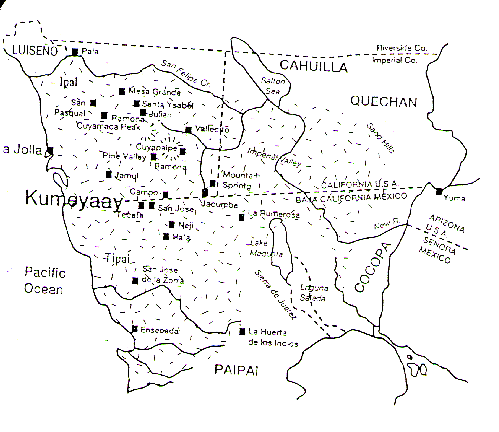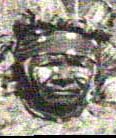PLACE NAMES IN IPAI LANGUAGE Learn
to Speak Ipai
Jamul Hamuull “to gather small objects” A type of berry grows
there that the people
used to gather; the name may refer to that.
Japatul Valley Hapetuly “a large basket"
Sequan Creek Sekwan (name for the flower that grows
there), Sequan Indian Res.
Capitan Grande 'E-quilsch a-mahk “Behind the mountains” the name
of the
Capitan Grande Indian village.
Cottontail rabbit house HUTS-LOW IN-YOU-WAH “Cottontail rabbit
house”.
See Helsh-ow Wa-wa
Baron Long (Viejas) Mat Kwa’tay “big land”
Valle de la Viejas MATARGO “Middle of the Valley”, the Indian
name applied
to Valle de la Viejas.
Tecate tuukatt “he cuts".
La Jolla Ilehup ‘hole” cave. In one dialect
the name for La Jolla would be
Mat Kulaahuuy “place of caves. “ But in another dialect of Diegueno, it
is
Mat kulaahuuy which is closer the modern name.
Inaja ‘Enyehaa “my water”
Poway Pawiiy “arrowhead”
Mesa Grande Tekemak “sheltered place” Chemilly Nyewaa (“ant’s house”)
is a
place by Mesa Grande. It has no official name in English.
Santa Ysabel ‘Ellykwanan “small mound made
by a mole”
Warner’s Hot Springs Haakupin “warm water”
San Felipe ‘Ewimally “moving snake”
 |
Mt. Woodson ‘Ewiiy Hellyaa “moon rock”
Guatay This either comes from waa tay “big house” or kwa’tay “the
big one.”
MlLQUATAY “Big plain”, the Indian name applied to the Campo region.
| Campo Matehay “wetland” Mataguay Mataguay Creek Mataahway “the place of white clay” The people used the clay there to paint their faces for ceremonials. Another possibility, but less likely, is that it means matiihwaay “battlefield. “ Inkopah mountains Enykipaa (This is the name of Inkopah County Park) a particular group of Dieguenos Inkopah Gorge that lived east of San Felipe, near Santanack. |
 |
Carrizo “Cane” AMTA (HAPAWU) , a village at Carrizo. The
Indians of the near
desert villages visited the Cuyamaca regions during acorn season.
Mesa Grande Tekemak “sheltered place”
Chemilly Nyewaa “ant’s home" is a place by Mesa
Grande, with no
official name in English
Cuyamaca See Ah-ha Kwe-ah-mac
Capitan Grande Indian village E-QUlLSCH A-MAHK “Behind the mountains,”
the name of the Capitan Grande Indian village.
The following list of Indian place names appertain to the entire cultural area of the Cuyamaca Indians: Rancho Cuyamaca, Cuyamaca Rancho State Park, and the mountainous region adjacent which was occupied the Kwaamii peoples.
Cuyamaca ‘Ekwiiyemak “behind the clouds “
Cuyamaca Ah-ha Kwe-ah-mac
ACPACAWARA A hill near Green Valley formerly covered with prickly pear cactus.
Sweetwater River AH-HA-OOO-MULK “Water sweet”
Spanish name was Agua Dulce.
AHA-HAKAIK, or INYAHKAI Name of a village in the Laguna Mts.
AH-HA KWE-AH-MAC “Water beyond”, or “behind”. Applied first to the Middle Peak; then to the group of three peaks; and also to the village at the south side of Cuyamaca Valley.
Laguna Mountains AH-HA MUT-TA-TIE “Water mountains”
AH-HA-WA-PIN “Water house”.
AH-HA WI-AH-HA “Water colder water”, a cold spring located high on the
northeast side of the South Peak.
EEL-SHA-HAR “Grows only here”, the name applied to the rare cypress which
grew only on the north side of Guatay mountain.
North Peak E-YEE, IGUAE, or IGUAI Ygnai “The nest”, a name given to a cave
on the west side of the peak where wild animals found refuge from bad weather or
hunters; also applied to the North Peak; also to the Indian village located on the
lower northeast slope of the peak.
GUAGAPIN CREEK “Huacupin” MESA DE HUACUPIN, the name of the largest of five villages in the canyon of this creek It leads up from Green Valley to the East Mesa.
White rock AH KWER-UP “Disease cure”, a huge white rock on the
west side
of South Peak thought to have magic curative powers
AM-WEE-AH-PI PAH The name of a slanting rock on South Peak.
ANAJA “Lasting water”, the name of an Indian village on the west
slope of North Peak. Anahuac was also the official name of the school
district.
ASSAYA An Indian village about one and one-half miles southwest
of Julian.
Stonewall Peak COOSH-PI “Sharp peak”.
COSMIT A small area now belonging to the Inaja Indian reservation
HILSH KIE; “Pine tree”, the Indian name for Corte Madera Mountain.
See text of
the story of Pammum Am-wah and Its Mythical Mountain.
Hanging head HUTS-TAH TAH-MIL-TAH “Hanging head”, a place high
up on
the west side of South Peak, and on the old High Trail.
IGUAE, or IGUAI See E-yee
JUAL-CU-CUILSH “Tough strong”, the name applied to Middle Peak;
and to the
village at the southeast base of the mountain.
MATACOUAT A village located on Cottonwood Creek, between Pine Valley
and Campo.
METO-PITL-PIT “Tall (or) strong man”, a place in the deep gorge
of Sweetwater
River below Green Valley Falls, thought by the Indians to be the home
of a cruel and powerful giant. Exact site not identified.
MITARAGUI “Crooked land”, the name of village in the upper end
of Green Valley.
NA-WA TI E “Big house”. See Guatay
NET NOOK An Indian village located in Mason Valley
OON-YA KWOLT “High trail”, located on the “enchanted” west side of
South Peak.
PAM-MUM AM-WAH, or PAMAUAUA The name of the village at the south
end
of the Green Valley Falls campground. It overlooks Green Valley Falls.
PASAS COSAR now Boulder Creek Laguna que se seca “Lake that
dries up”
(in summer) Now center of Cuyamaca Lake.
PILGHA The village on the West Mesa, probably the same as the
Arrow Makers’
Camp, which overlooks upper Green Valley. Also applied to the creek or
canada
which flows to the west of the village site.
PILCH OOM-WA “White as ashesn, a small village in Little Guatay
Valley (now
Little Descanso Valley) just west of the Sweetwater River and south of
the Descanso
Post Office.
PISCLIMI or PISCLIM A village site south of the Park
Headquarters. .
South Peak POO-KWOO-SQUEE “Crooked neck”, the name given to South
Peak.
PUERTO SUELO - gate-way or southwest entrance to grant from Valle
de las Viejas
up a steep canyon into Valle de Guatay.
Viejas Mountain KWUT AH LU E-AH “Song dance”